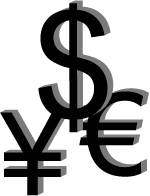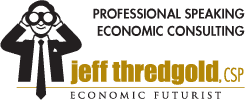|
July 16, 2008
Dollar
Written by Jeff Thredgold, CSP, President, Thredgold Economic Associates
 A significant downward move in the U.S. dollar versus other major global currencies has occurred over the past few years. Such a development, like so many others in “the dismal science of economics,” finds financial market participants, manufacturers, exporters, importers, hoteliers, travel agents, etc. being positively or negatively impacted by measurable shifts in currency values. A significant downward move in the U.S. dollar versus other major global currencies has occurred over the past few years. Such a development, like so many others in “the dismal science of economics,” finds financial market participants, manufacturers, exporters, importers, hoteliers, travel agents, etc. being positively or negatively impacted by measurable shifts in currency values.
A simple view would suggest that U.S.-based manufacturers, incurring costs and selling products based in dollars, would tend to benefit from a weaker dollar as their ability to compete with foreign producers of similar products is enhanced. Conversely, periods when the U.S. dollar is stronger lead to U.S. manufacturers selling products around the world that are less competitive versus alternative products produced outside the U.S.
Recent years have found the U.S. dollar particularly weak versus the euro currency. After being valued by foreign exchange markets at roughly $1.17 when first introduced in 1999, the euro fell 30% in value within two years. A subsequent rebound and retreat in euro value occurred during the following two years. A sustained rise in the euro’s value versus the U.S. dollar has been in place during the past 3-4 years, with the euro reaching $1.60 before weakening somewhat.
Winners and Losers
Life has been particularly good for Europeans traveling to the U.S. as tourists and shoppers over the past two years as the value of the euro led to great bargains of all shapes and sizes. Significant purchases of U.S. real estate by European and English investors have also helped to clear excess housing inventories on the East Coast.
European exporters, however, are sweating bullets as their products have become more and more expensive in the U.S. European hotels, restaurants, museums, etc. seeking large numbers of visitors from the U.S. this summer are keeping their fingers collectively crossed.
Note: While the national media would have one believe the U.S. dollar has been getting widely trashed in recent years, such is not necessarily the case. The U.S. dollar on a trade-weighted basis has returned to a level commensurate with the mid-1990s (source: Federal Reserve Bank of Atlanta). Currencies simply have periods of significant strength and weakness, similar to any other “commodity.”
Recent $ Weakness
What has led to the more pronounced decline in the U.S. currency’s value versus the euro, the Japanese yen, the British pound, the Canadian dollar, etc. in recent years?
Initial dollar weakness was tied to the enormous trade imbalance the U.S. runs with major trading partners around the world. A trade imbalance near $750 billion annually, more than $2 billion daily, simply led to an excess of dollars around the globe.
U.S. consumers bought goods, oil, autos, minerals, etc. from producers around the globe and paid for them with more and more dollars. Supply & demand…the basic premise of economics…actually does work sometimes. An excess supply of dollars led their value lower.
More recently, aggressive cuts by the Federal Reserve to its key short-term interest rates between September 2007 and April 2008 led dollar-denominated investments to lower yields (or investment returns) versus comparable investments in euro- or pound-based investments. The sharp decline in U.S. interest rates stood in stark contrast to any lack of interest rate cuts by the European Central Bank (ECB), even as European economic growth began to stall.
In fact, the ECB actually raised its key rate on July 3 by 0.25% to address excessive inflation. Why? The policy mandate of Europe’s central bank is much more focused on inflation containment than is that of the Federal Reserve, America’s central bank. A European history of two German periods of hyperinflation following World War I and World War II led to the inflation containment focus.
So Where Do We Go From Here?
Financial market participants are split as to where the dollar’s value will move during 2008’s second half and during 2009.
Dollar “bears” would argue that the recent period of relative dollar stabilization will eventually give way to further dollar weakness. These bears would argue that the U.S. trade imbalance with the world, even as it declined slightly over the past 18 months, is still out of kilter enough to lead to further dollar weakness.
Dollar “bulls” would argue that U.S. currency weakness of the past few years has been excessive. Such bulls would argue that some strengthening of the dollar is likely. These dollar strength advocates would suggest that the dollar realignment of the past few years greatly enhances the competitive position of U.S. manufacturers, suggesting stronger merchandise export growth, which is occurring.
Over time, I look at the relative value of a currency to a country as similar to the value of a stock to a company. An investor wants to hold stock in a company that has solid growth potential and higher earnings prospects. In a similar way, one can view the value of a currency.
An investor prefers to own a currency of a nation that has solid economic fundamentals, a competitive economy, and liquid investment markets. Such a view can favor the United States and its currency.
My View
My outlook for the U.S. dollar suggests some strengthening, especially versus the euro, will occur during the next year. What drives this view? First of all, prospects for better U.S. economic growth are rising as economic weakness (or recession) during 2008 is likely to give way to somewhat better performance during 2009.
Second, the Federal Reserve has (presumably) concluded its aggressive monetary ease, with seven interest rate cuts between September 18, 2007 and April 30, 2008 trimming the critical federal funds rate from 5.25% to 2.00%. The consensus view of economists now suggests that the Fed’s next move could be to push its key rates higher, although not until later this year or early in 2009.
Third, the national media’s constant negativity toward the U.S. housing sector could move toward a more neutral stance later this year, potentially leading numerous global investors to see greater value in American housing, thus stimulating demand for dollars. Fourth, further progress in reducing the U.S. trade imbalance with the world is likely, especially if oil prices decline during latter 2008 and during 2009 from recent levels above $140 per barrel.
• Email this article to a friend
• Learn about econAmerica, Jeff’s latest book
|
|
Subscribe to the Tea Leaf
Like what you just read? Have Jeff Thredgold’s Tea Leaf emailed to you free each week. Subscribe today.
|
|
|

“Tea”ser
In spite of the cost of living, it’s still popular.
• Send us a “Tea”ser

“Tea”stimonial
“I want to sincerely thank you for your excellent presentation given at The Powder Coating Institute Annual Meeting in San Antonio. Your economic outlook was both educational and entertaining. I also thank you for taking the time to meet with members both before and after your presentation. You were great to work with, a true professional in every sense of the word!”
—Gregory J. Bocchi, Executive Director, The Powder Coating Institute
• More testimonials
Invite Jeff Thredgold to speak at your next conference, meeting, or client function
If you like the Tea Leaf, you’ll love Jeff Thredgold’s live presentations. Jeff takes your audience on a timely, engaging, and entertaining tour of the U.S. economy and financial markets. Debunking some of today’s most common economic myths, he offers a clear picture of how the American economy is really performing and what that means for the future of your finances.
• Watch video clips of a Jeff Thredgold presentation.
• Download more information that you can e-mail to other decision makers.
• See Jeff Thredgold’s speaking calendar.
• Tell us about your event using our online form and we will contact you. Or, is there an individual in your organization you would like us to contact?
• Give us a call at 1-888-THREDGOLD (847-3346) to ask about Jeff’s availability and pricing for your event, or for any other information.
|
